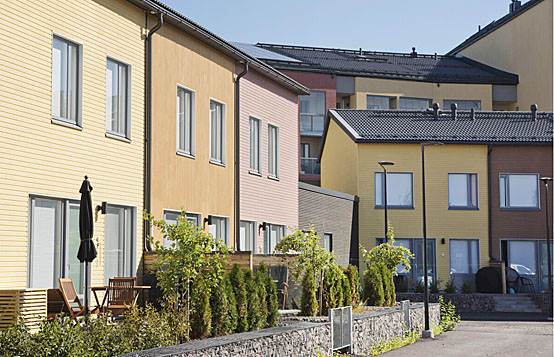
Kuninkaantammi residential area in Helsinki. © City of Helsinki
In the new Kuninkaantammi residential area, there will be in near future constructed apartment buildings of which procurement was steered by a low carbon footprint. In practice, this means that in addition to increasing energy efficiency the aim is to minimize the emissions of construction and material production.
Currently, the City of Helsinki is being built actively in existing residential areas and by creating new areas. In the city development, aim is towards an ecologically, socially and economically sustainable city. When addressing the emission reductions of construction, the attention is usually directed towards decreasing the energy consumption during use. However, as the energy efficiency of buildings continues to improve, the emissions from the construction and manufacture of materials are constantly increasing in importance.
To tackle the challenge, city is currently developing its existing procurement criteria based on its climate goals and introducing new ones that take the lifecycle impact, circular economy and climate perspective into account better. With help of Canemure project, the Helsinki Housing Production Department examined in Asetelmakatu DB project how building’s carbon footprint can be reduced in tendering.
Climate criteria in the quality comparison
The objective of the Asetelmakatu DB project was to find a low-carbon design solution for the construction project, that is high-quality and feasible in terms of architecture and the cityscape, as well as a constructor. The procurement was intended to reduce the project’s climate and environmental impacts by setting several minimum requirements and comparison criteria to steer the design and the construction.
The central goal was to find out what kind of a steering effect can be achieved with the carbon footprint of the project as part of the procurement’s scoring. “We are actively exploring the best way to control low-carbon construction. Carbon footprint calculations for the entire life cycle of buildings have been carried out on several projects and are being increased all the time. However, for the first time, we gained experience in use of the carbon footprint as a procurement criterion”, says Jonna Seppänen, an environmental expert from Helsinki Housing Production.
Climate criteria to guarantee low-carbon implementation of the project
Two bidders took part in the tender, of which, unfortunately, a proposal with a more ambitious climate impact left the competition after the customer entered the negotiated procedure due to incomplete bids. The environmental criteria used in the comparison also did not work as expected in the competition between the two bidders. Instead, the other environmental criteria applied in the procurement have a significant impact on reducing the environmental impact of the procurement and ensure that the project is realized in a low-carbon manner.
The parties were happy with the agreement that was ultimately reached, and an architecturally ambitious solution from an operator specialising in wood construction was achieved with the procurement. The lessons learned from the project will be useful in the future when the carbon footprint of new buildings is regulated by law in Finland. Read more learnings from our case description.
In addition, the Asetelmakatu DB project is the City of Helsinki’s first test platform for the criteria for a fossil-free worksite in building construction projects. The city of Helsinki has signed a green deal to reduce emissions at construction sites. With the deal, the City aims to achieve fossil free construction sites and increase the percent of construction machinery and site transports that are powered by electricity, biogas or hydrogen.
Read more